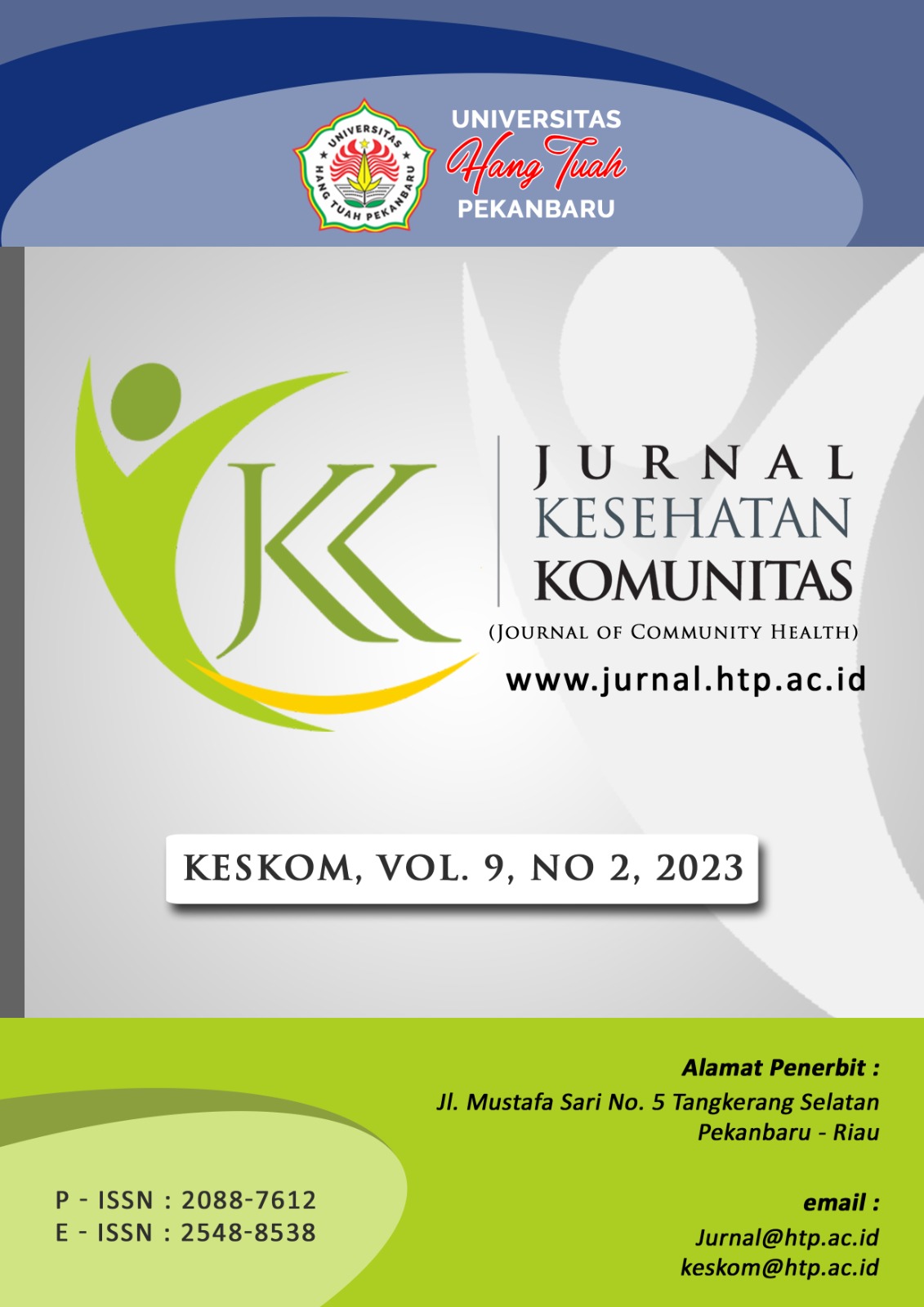Analysis of Stunting Handling Strategies in Bangun Sari Village, Kampar Kiri Hilir District, Kampar Regency, Riau Province in 2021
DOI:
https://doi.org/10.25311/keskom.Vol9.Iss2.1365Abstract
Stunting is a condition of a child's growth disorder, namely the child's height is shorter (dwarf) than the standard age, which is <-2 SD. Kampar Regency is one of the highest-ranked stunting rates in Riau Province in 2018 which is 31.99% and increased in 2019 to 32.05%. The purpose of this study was to analyze the stunting management strategy in Bangun Sari Village, Kampar Regency, Riau Province. The study used qualitative methods through in-depth interviews, observation, and document review with 8 research informants. The results obtained are that there is still a lack of allocation of village funds budgeted by village officials. The health promotion provided has not been well received by the community. The inter-sectoral support that has been established has been running quite well. Food security has been provided and distributed, but in reality, the food aid is not consumed well by the community due to poor parenting by parents. Monitoring and evaluation have been carried out quite well. The conclusion of this study is that the commitment, vision, mission, health promotion, cross-sectoral support, food security, and monitoring of stunting have been sufficient and distributed by the UPTD of the Kampar Kiri Hilir Health Center.
Downloads
References
WHO. Levels and Trends in Child malnutrition - Unicef WHO The World Bank Joint Child Malnutrition Estimates, key findings pf the 2019 edition. Unicef [Internet]. 2019;4. Tersedia pada: http://www.unicef.org/media/files/JME_2015_edition_Sept_2015.pdf%0Ahttps://pubmed.ncbi.nlm.nih.gov/30430613/
Kemenkes RI. Profil Kesehatan Indonesia 2019. Kemenkes RI, editor. Jakarta; 2019.
Kemenkes RI. Buletin Stunting. Kementeri Kesehat RI. 2018;301((5)):1163–1178.
Riskesdas K. Laporan Provinsi Riau Riskesdas 2018. 2018. 540 hal.
Dinkes Kab Kampar. Profil Kesehatan Kabupaten Kampar Tahun 2020. Dinas Kesehat Sleman. 2020;(6):1–173.
Kemenkes RI. Cegah Stunting Itu Penting. War Kesmas. 2018;02:1– 27.
Manalu HSP. Peran Tenaga Kesehatan Dan Kerjasama Lintas Sektor. J Ekol Kesehat. 2014;13(1).
Pratiwi SR. Manajemen kampanye komunikasi kesehatan dalam upaya pengurangan prevalensi balita stunting. J Manaj Komun. 2019;4(1):1–23.
Arifin S. Buku Ajar Dasar-Dasar Manajemen Kesehatan. Banjarmasin: Pustaka Benoa; 2016.
Kemenkes RI. Pedoman Pelaksanaan Promosi Kesehatan di Puskesmas [Internet]. Vol. 1, Records Management Journal. 2019. 1–15 hal. Tersedia pada: http://citeseerx.ist.psu.edu/viewdoc/download?doi=10.1.1.88.5042&rep=rep1&type=pdf%0Ahttps://www.ideals.illinois.edu/handle/2142/73673%0Ahttp://www.scopus.com/inward/record.url?eid=2-s2.0-33646678859&partnerID=40&md5=3ee39b50a5df02627b70c1bdac4a60ba%0Ahtt
Manggala T. Faktor-Faktor Keberhasilan Program Promosi Kesehatan “Gempur Stunting” Dalam Penanganan Stunting di Puskesmas Rancakalong Sumedang. Cover J Strateg Commun. 2021;11(2):88–98.
Pradana FK, Sriatmi A, Kartini A. Evaluasi proses dalam program penanganan stunting di Semarang. HIGEA (Journal Public Heal Res Dev [Internet]. 2021;5(1269):587–95. Tersedia pada: http://journal.unnes.ac.id/sju/index.php/higeia
Peraturan Presiden (PERPRES). Peraturan Presiden (PERPRES) tentang Gerakan Nasional Percepatan Perbaikan Gizi. Jakarta; 2013.
Nefy N. Implementasi Gerakan 1000 Hari Pertama Kehidupan di Kabupaten Pasaman 2017. Media Gizi Indones. 2019;14(2):186–96.
Putri ASR, Mahmudiono T. Efektivitas Pemberian Makanan Tambahan (PMT) Pemulihan Pada Status Gizi Balita di Wilayah Kerja Puskesmas Simomulyo, Surabaya. Amerta Nutr. 2020;4(1):58.
Kemenkes RI. UNDANG-UNDANG REPUBLIK INDONESIA NOMOR 36 TAHUN 2009 TENTANG KESEHATAN. Jakarta: Kementerian Kesehatan RI Pusat Promosi Kesehatan; 2009.
DPR RI. UNDANG-UNDANG REPUBLIK INDONESIA NOMOR 18 TAHUN 2012 TENTANG PANGAN. Jakarta: Jaringan Dokumentasi dan Informasi Hukum Kementerian BUMN; 2012.
Putri ASR. Efektivitas Pemberian Makanan Tambahan (PMT) Pemulihan Pada Status Gizi Balita di Wilayah Kerja Puskesmas Simomulyo, Surabaya. Amerta Nutr. 2020;4(1):58–64.
Downloads
Submitted
Accepted
Published
How to Cite
Issue
Section
License
Copyright (c) 2023 Jurnal Kesehatan Komunitas

This work is licensed under a Creative Commons Attribution-NonCommercial-ShareAlike 4.0 International License.
Copyright @2017. This is an open-access article distributed under the terms of the Creative Commons Attribution-NonCommercial-ShareAlike 4.0 International License (http://creativecommons.org/licenses/by-nc-sa/4.0/) which permits unrestricted non-commercial used, distribution and reproduction in any medium












































